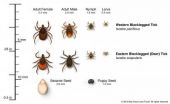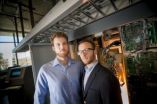(Press-News.org) WORCESTER, MA – Using population-based screening outcomes of approximately 3 million infants, a team of scientists across 14 states, including four researchers at the University of Massachusetts Medical School, have shown that newborn screening for severe combined immunodeficiency (SCID) can be successfully implemented across public health newborn screening programs. Data from 11 newborn screening programs published in the Aug. 20 issue of the Journal of the American Medical Association (JAMA) showed the rate of SCID in newborns is higher than previously thought and believed to be 1 in 58,000.
Newborn screening programs enable early detection of conditions for which prompt treatments can reduce the risk of death or irreversible damage. The first heritable immune disorders to which newborn screening has been applied are those that together comprise severe combined immunodeficiency. SCID babies are born without a developed immune system and are subject to a wide variety of life-threatening infections. However, the advance of stem cell transplantation to replace the immune system, coupled now with the opportunity to identify SCID early through newborn screening, holds the promise that affected children can lead normal, healthy lives. Early detection is critical for treatment of SCID and, in most cases, population-based testing through newborn screening programs is the only means to detect SCID prior to the onset of infections.
Unlike other conditions included in newborn screening, SCID requires a DNA-based testing strategy for every infant screened. In 2008, Wisconsin and Massachusetts were awarded grants from the Centers for Disease Control to develop, demonstrate and transfer testing strategies that could be adopted by other newborn screening programs. With data generated by these pilot programs, SCID was added to the national recommended uniform panel for newborn screened disorders in 2010. Currently 23 states, the District of Columbia and the Navajo Nation screen approximately two-thirds of all infants born in the United States for SCID.
The New England Newborn Screening Program, which is operated by the University of Massachusetts Medical School, has been performing newborn screening in Massachusetts since 1962 and now provides screening for about 500 newborns every day in Massachusetts, Maine, New Hampshire, Rhode Island and Vermont; SCID screening has been offered statewide in Massachusetts since early 2009 and Maine and Rhode Island recently authorized the New England Newborn Screening Program to test infants for SCID.
Antonia Kwan, PhD, MRCPCH, of the University of California, San Francisco, and collaborators, including members from the Massachusetts SCID Newborn Screening Working Group, conducted the analysis of more than 3 million infants screened for SCID in 10 states and the Navajo Nation. Infants born from the start of each participating program from January 2008 through the most recent evaluable date prior to July 2013 were included.
There were 52 SCID cases identified within the cohort, for an overall incidence of 1 in 58,000 births, up from the previous estimate of 1 in 100,000 births.
The incidence was not significantly different in any state program but was higher in the Navajo Nation (1/3,500), attributed to a genetic mutation found in this population. Survival of SCID-affected infants through their diagnosis and immune reconstitution was 87 percent, and 92 percent for infants who received transplantation, enzyme replacement and/or gene therapy. Additional interventions for SCID and non-SCID T-cell lymphopenia (abnormally low level of certain white blood cells) included immunoglobulin infusions, preventive antibiotics and avoidance of live vaccines. The observed short term outcomes confirm the benefit of newborn screening as was recently predicted by the retrospective study of transplantation outcomes from Pai et al (NEJM 371:5 July 31, 2014).
"This paper is an excellent example of translational science and medicine yielding the successful public health system necessary for early diagnosis and treatment of SCID," said Anne Marie Comeau, PhD, deputy director of the New England Newborn Screening Program and professor of pediatrics at the University of Massachusetts Medical School. "It's a pleasure to see that Massachusetts' early efforts with Wisconsin and the Centers for Disease Control to ensure high quality, high-throughput DNA-based screening and clinical protocols have been fruitful. When emerging technologies that require technical competence, protocol sharing and training are combined with appropriate clinical expertise and integrated within the public health system, there is a positive effect on babies' lives. The study shows that multiple states, all participating in quality assurance programs run by the CDC, implemented a new technology and many babies benefited."
"As the second state to implement screening for SCID, we are proud to have contributed to the development of algorithms for early detection and treatment of these rare disorders," said Beverly Hay, MD, chief of pediatric genetics at UMass Memorial Medical Center and assistant professor of pediatrics at the University of Massachusetts Medical School. "The incidence of SCID was found to be higher than previously estimated, suggesting that SCID was likely under-recognized and underdiagnosed in the past. Early detection allows for treatment before a child becomes overwhelmingly ill, which leads to a better outcome for that child."
INFORMATION:
About the University of Massachusetts Medical School
The University of Massachusetts Medical School (UMMS), one of five campuses of the University system, comprises the School of Medicine, the Graduate School of Biomedical Sciences, the Graduate School of Nursing, a thriving research enterprise and an innovative public service initiative, Commonwealth Medicine. Its mission is to advance the health of the people of the commonwealth through pioneering education, research, public service and health care delivery with its clinical partner, UMass Memorial Health Care. In doing so, it has built a reputation as a world-class research institution and as a leader in primary care education. The Medical School attracts more than $240 million annually in research funding, placing it among the top 50 medical schools in the nation. In 2006, UMMS's Craig C. Mello, PhD, Howard Hughes Medical Institute Investigator and the Blais University Chair in Molecular Medicine, was awarded the Nobel Prize in Physiology or Medicine, along with colleague Andrew Z. Fire, PhD, of Stanford University, for their discoveries related to RNA interference (RNAi). The 2013 opening of the Albert Sherman Center ushered in a new era of biomedical research and education on campus. Designed to maximize collaboration across fields, the Sherman Center is home to scientists pursuing novel research in emerging scientific fields with the goal of translating new discoveries into innovative therapies for human diseases.
Newborn screening expansion offers early diagnosis and treatment to infants with SCID
Testing of newborns for SCID reveals higher disease rates than previously believed
2014-08-20
ELSE PRESS RELEASES FROM THIS DATE:
Lyme disease risk is year-round in Northwest California, according to new study
2014-08-20
SILICON VALLEY, Calif., August 19, 2014 -- Bay Area Lyme Foundation, which aims to make Lyme disease easy to diagnose and simple to cure, applauds new research published in an upcoming issue of the Elsevier peer review journal Ticks and Tick-borne Diseases. The findings show that ticks that carry Lyme disease in Northwest California are active throughout the year, making the threat of Lyme disease year-round. The research was conducted by researchers at California Department of Public Health (CDPH) Vector-borne Disease Section and University of California, Berkeley (UC-B).
"These ...
NASA sees Tropical Storm Lowell's tough south side
2014-08-20
VIDEO:
NOAA's GOES-14 satellite was brought out of storage and put in Super Rapid Scan Operations for GOES-R mode and data of Tropical Storm Lowell from Aug. 19 was animated....
Click here for more information.
The south side of Tropical Storm Lowell appears to be its toughest side. That is, the side with the strongest thunderstorms, according to satellite imagery from NOAA's GOES-14 and NASA-NOAA's Suomi NPP satellites.
NOAA took its GOES-14 satellite out of storage to simulate ...
Gene therapy protects mice from lethal heart condition, MU researchers find
2014-08-20
COLUMBIA, Mo. — A new gene therapy developed by researchers at the University of Missouri School of Medicine has been shown to protect mice from a life-threatening heart condition caused by muscular dystrophy.
"This is a new therapeutic avenue," said Yi Lai, Ph.D., the leading author of the study and assistant research professor in the MU School of Medicine's Department of Molecular Microbiology and Immunology. "This is just a first step, but we hope this could lead to a treatment for people with this devastating heart condition, which is a leading cause of death for ...
Providing futile care in the ICU prevents other patients from receiving critical care
2014-08-20
Providing futile treatment in the intensive care unit sets off a chain reaction that causes other ill patients needing medical attention to wait for critical care beds, according to a study by researchers from UCLA and RAND Health.
The study is the first to show that when unbeneficial medical care is provided, others who might be able to benefit from treatment are harmed, said study lead author Dr. Thanh Huynh, an assistant professor of medicine in the division of pulmonary and critical care medicine at the David Geffen School of Medicine at UCLA.
The findings also ...
Novel gene predicts both breast cancer relapse and response to chemotherapy
2014-08-20
Singapore—Scientists have made it easier to predict both breast cancer relapses and responses to chemotherapy, through the identification of a unique gene. The newly found marker could help doctors classify each breast cancer patient and customise a treatment regimen that is more effective. The discovery was a collaborative effort by scientists from A*STAR's Institute of Molecular and Cell Biology (IMCB), and the Cancer Science Institute of Singapore (CSI Singapore) at the National University of Singapore (NUS).
Despite advancements in cancer treatment, breast cancer ...
Record decline of ice sheets
2014-08-20
"The new elevation maps are snapshots of the current state of the ice sheets. The elevations are very accurate, to just a few metres in height, and cover close to 16 million km2 of the area of the ice sheets. This is 500,000 square kilometres more than any previous elevation model from altimetry", says lead-author Dr. Veit Helm, glaciologist at the Alfred Wegener Institute in Bremerhaven.
For the new digital maps, the AWI scientists had evaluated all data by the CryoSat-2 altimeter SIRAL. Satellite altimeter measure the height of an ice sheet by sending radar or laser ...
Researchers find security flaws in backscatter X-ray scanners
2014-08-20
A team of researchers from the University of California, San Diego, the University of Michigan, and Johns Hopkins University have discovered several security vulnerabilities in full-body backscatter X-ray scanners deployed to U.S. airports between 2009 and 2013.
In laboratory tests, the team was able to successfully conceal firearms and plastic explosive simulants from the Rapiscan Secure 1000 scanner. The team was also able to modify the scanner operating software so it presents an "all-clear" image to the operator even when contraband was detected. "Frankly, we were ...
Testing the shelf-life of nuclear reactors
2014-08-20
Oxford, August 20, 2014 – Researchers at the University of Michigan, Ann Arbor, Los Alamos National Laboratory, Idaho National Laboratory, Idaho Falls and TerraPower based in Bellevue, Washington, have demonstrated the power of high-energy beams of charged particles (ions). The ions can rapidly and consistently damage samples of ferritic-martensitic steel, the material used in certain nuclear reactor components. The significance of the result is that the breakdown closely replicates that seen when high-energy neutrons from a nuclear reactor interact with the material - ...
Chemically extracted acellular allogeneic nerve graft with CNTF for sciatic nerve repair
2014-08-20
Chemically extracted acellular allogeneic nerve, from which Schwann cells, myelin sheath and disintegrating fragments have been removed, reduced postoperative immune rejection. Simultaneously, chemically extracted acellular allogeneic nerve retains neural substrates and base materials, such as the bottom layer of Schwann cells, which can provide a good scaffold in the process of nerve regeneration. Chemically extracted acellular allogeneic nerve, similar to autologous nerve transplantation, can guide nerve regeneration and provide a favorable local environment for neural ...
The channel that relaxes DNA
2014-08-20
VIDEO:
This is a model DNA chain inside a nanochannel that is 100nm wide.
The spontaneous dynamical evolution of the DNA is accompanied by frequent knotting and entanglement at the chain ends....
Click here for more information.
With the widespread use of methods for DNA analysis and manipulation, it's certainly useful to find a way to unravel and relax the strands of this molecule that tends to form tangles spontaneously. One way is to use channels, or rather nano-channels, ...
LAST 30 PRESS RELEASES:
Personalised “cocktails” of antibiotics, probiotics and prebiotics hold great promise in treating a common form of irritable bowel syndrome, pilot study finds
Experts developing immune-enhancing therapies to target tuberculosis
Making transfusion-transmitted malaria in Europe a thing of the past
Experts developing way to harness Nobel Prize winning CRISPR technology to deal with antimicrobial resistance (AMR)
CRISPR is promising to tackle antimicrobial resistance, but remember bacteria can fight back
Ancient Maya blessed their ballcourts
Curran named Fellow of SAE, ASME
Computer scientists unveil novel attacks on cybersecurity
Florida International University graduate student selected for inaugural IDEA2 public policy fellowship
Gene linked to epilepsy, autism decoded in new study
OHSU study finds big jump in addiction treatment at community health clinics
Location, location, location
Getting dynamic information from static snapshots
Food insecurity is significant among inhabitants of the region affected by the Belo Monte dam in Brazil
The Society of Thoracic Surgeons launches new valve surgery risk calculators
Component of keto diet plus immunotherapy may reduce prostate cancer
New circuit boards can be repeatedly recycled
Blood test finds knee osteoarthritis up to eight years before it appears on x-rays
April research news from the Ecological Society of America
Antimicrobial resistance crisis: “Antibiotics are not magic bullets”
Florida dolphin found with highly pathogenic avian flu: Report
Barcodes expand range of high-resolution sensor
DOE Under Secretary for Science and Innovation visits Jefferson Lab
Research expo highlights student and faculty creativity
Imaging technique shows new details of peptide structures
MD Anderson and RUSH unveil RUSH MD Anderson Cancer Center
Tomography-based digital twins of Nd-Fe-b magnets
People with rare longevity mutation may also be protected from cardiovascular disease
Mobile device location data is already used by private companies, so why not for studying human-wildlife interactions, scientists ask
Test reveals mice think like babies
[Press-News.org] Newborn screening expansion offers early diagnosis and treatment to infants with SCIDTesting of newborns for SCID reveals higher disease rates than previously believed






